Related Research Articles
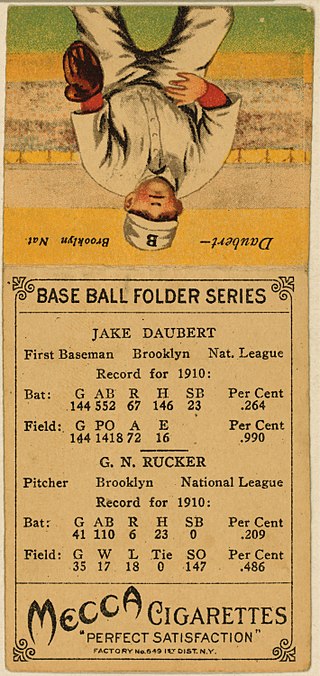
Baseball statistics include a variety of metrics used to evaluate player and team performance in the sport of baseball.
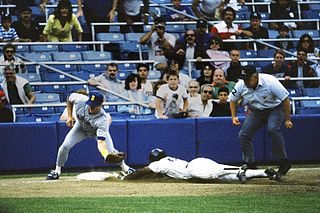
In baseball, a stolen base occurs when a runner advances to a base unaided by other actions and the official scorer rules that the advance should be credited to the action of the runner. The umpires determine whether the runner is safe or out at the next base, but the official scorer rules on the question of credit or blame for the advance under Rule 10 of the MLB's Official Rules.

Softball is a popular variation of baseball, the difference being that it is played with a larger ball, on a smaller field, and with only underhand pitches permitted. Softball is played competitively at club levels, the college level, and the professional level. The game was first created in 1887 in Chicago by George Hancock.
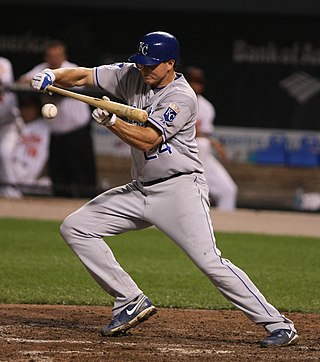
A bunt is a batting technique in baseball or fastpitch softball. Official Baseball Rules define a bunt as follows: "A bunt is a batted ball not swung at, but intentionally met with the bat and tapped slowly within the infield." To bunt, the batter loosely holds the bat in front of home plate and intentionally taps the ball into play. A properly executed bunt will create weak contact with the ball and/or strategically direct it, forcing the infielders to make a difficult defensive play to record an out.
In baseball, a sacrifice bunt is a batter's act of deliberately bunting the ball, before there are two outs, in a manner that allows a baserunner to advance to another base. The batter is almost always put out, and hence sacrificed, but sometimes reaches base on an error or fielder's choice. In that situation, if runners still advance bases, it is still scored a sacrifice bunt instead of the error or the fielder's choice. Sometimes the batter may safely reach base by simply outrunning the throw to first; this is not scored as a sacrifice bunt but rather a single.
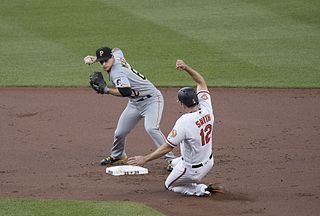
In baseball and softball, a double play is the act of making two outs during the same continuous play. Double plays can occur any time there is at least one baserunner and fewer than two outs.
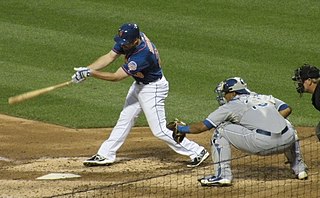
Catcher is a position in baseball and softball. When a batter takes their turn to hit, the catcher crouches behind home plate, in front of the (home) umpire, and receives the ball from the pitcher. In addition to this primary duty, the catcher is also called upon to master many other skills in order to field the position well. The role of the catcher is similar to that of the wicket-keeper in cricket.

In baseball, an intentional base on balls, usually referred to as an intentional walk and denoted in baseball scorekeeping by IBB, is a walk issued to a batter by a pitcher with the intent of removing the batter's opportunity to swing at the pitched ball. A pitch that is intentionally thrown far outside the strike zone for this purpose is referred to as an intentional ball.
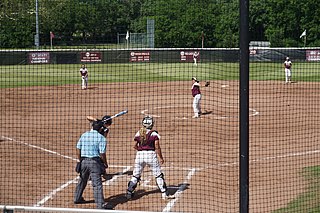
In baseball or softball, a pitchout is a ball that is intentionally thrown high and outside the strike zone with the purpose of preventing a stolen base, thwarting a hit and run, or to prevent a run-scoring play on a suicide squeeze play. The pitcher delivers the ball in such a manner for it to be unhittable and in a position where the catcher can quickly leap to their feet to catch it. A well-thrown pitchout will allow the catcher to receive the ball standing up as opposed to their usual squat, giving them a better line to throw to a base without the pitcher or the batter obstructing their vision or aim. Moreover, it is easier to throw a ball with more force from a standing position than it is from a squat, which is why most catchers leap to their feet when attempting to throw out a base stealer. A pitchout is a type of intentional ball, but differs in that a pitchout is thrown harder to give the catcher the most time to throw out the base runner.
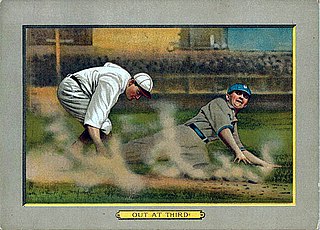
In baseball, an out occurs when the umpire rules a batter or baserunner out. When a batter or runner is out, they lose their ability to score a run and must return to the dugout until their next turn at bat. When three outs are recorded in a half-inning, the batting team's turn expires.

Throughout baseball's history, the rules have frequently changed as the game continues to evolve. A few common rules most professional leagues have in common are that four balls are a base on balls, three strikes are a strikeout, and three outs end a half-inning.

A baseball field, also called a ball field or baseball diamond, is the field upon which the game of baseball is played. The term can also be used as a metonym for a baseball park. The term sandlot is sometimes used, although this usually refers to less organized venues for activities like sandlot ball.
Baseball and cricket are the best-known members of a family of related bat-and-ball games. Both have fields that are 400 feet (120 m) or more in diameter between their furthest endpoints, offensive players who can hit a thrown/"bowled" ball out of the field and run between safe areas to score runs (points) at the risk of being gotten out, and have a major game format lasting about 3 hours.

In baseball, a pitcher may commit illegal motions or actions that constitute a balk. Most of these violations involve pitchers pretending to pitch when they have no intention of doing so. In games played under the Official Baseball Rules that govern professional play in the United States and Canada, a balk results in a dead ball or delayed dead ball. In certain other circumstances, a balk may be wholly or partially disregarded. In the United States, under the National Federation of State High School Associations, a balk results in an immediate dead ball. In the event a balk is enforced, the pitch is generally nullified, each runner is awarded one base, and the batter (generally) remains at bat with the previous count. The balk rule in Major League Baseball was introduced in 1898.
The Knickerbocker Rules are a set of baseball rules formalized by William R. Wheaton and William H. Tucker of the Knickerbocker Base Ball Club in 1845. They have previously been considered to be the basis for the rules of the modern game, although this is disputed. The rules are informally known as the "New York style" of baseball, as opposed to other variants such as the "Massachusetts Game" and "Philadelphia town ball".

In the sport of baseball, small ball is an informal term for an offensive strategy in which the batting team emphasizes placing runners on base and then advancing them into scoring position for a run in a deliberate, methodical way. This strategy places a high value on individual runs and attempts to score them without requiring extra base hits, or sometimes without base hits at all, instead using bases on balls, stolen bases, sacrifice bunt or sacrifice fly balls, the hit-and-run play, and aggressive baserunning with such plays as the contact play. A commonly used term for a run produced playing small ball is a "manufactured run". This style of play was more often found in National League game situations than in the American League due in large part to the absence of the designated hitter in the National League until the universal adoption of the Designated Hitter.
This is an alphabetical list of selected unofficial and specialized terms, phrases, and other jargon used in baseball, along with their definitions, including illustrative examples for many entries.
The 1939 Cincinnati Reds season was a season in American baseball. The team finished first in the National League, winning the pennant by 4+1⁄2 games over the St. Louis Cardinals with a record of 97–57. The team went on to the 1939 World Series, which they lost in four straight games to the New York Yankees.
The wheel play is a defensive strategy in baseball designed to defend against a sacrifice bunt. The play's name derives from the wheel-like rotation of the infielders.
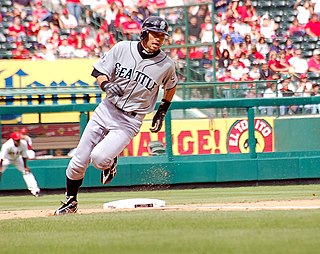
In baseball, base running is the act of running from base to base, performed by members of the team at bat.
References
- 1 2 3 "Painting the Black: Suicide is Painless". Baseball Prospectus. November 15, 2013. Retrieved August 30, 2020.
- ↑ "Year in Review: 1894 National League". Baseball Almanac. Retrieved 2018-08-11.
- 1 2 3 4 "A Bunt and a Prayer". The New York Times. August 20, 2006. Retrieved August 30, 2020.